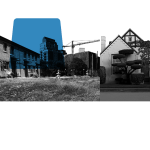Across the San Francisco Bay Area, inflated rents, uneven wage growth, and inadequate tenant protections have shaped the current iteration of our ongoing housing crisis. Today’s housing conditions are characterized by a severe housing-cost burden [1] and an unprecedented number of evictions.
In Oakland, where market speculation has unsettled whole neighborhoods and enterprising landlords have increased rents to some of the highest in the nation, the threat of displacement looms large, and the concept of affordability has been adjusted as more renters are forced to cope with overcrowding, health-negating conditions, and uncertain housing futures.[2]
After decades of deep federal and state disinvestment, the primary objective of many cities has been to generate and capture economic growth to fill critical funding gaps.
To identify the tools that local jurisdictions can employ to address housing instability (and its associated maladies), this discussion has entertained the following question: What do cities have the power to do? Taken in isolation, this question is a reasonable one. However, as part of a broader conversation, I fear that it starts us down a path that will take us further from the lived experiences of housing instability and the propensity for local institutions to facilitate the very instability we seek to fix.
If the intention is to explore how we might find a more tenable, health-promoting approach to housing and to assess what is possible, I offer a more reflexive but pointed question: What is the function of cities? I offer this as an alternative because if a city exists to capture the economic benefits of the growth machine and to facilitate the development that feeds said machine, then we must first reconcile how cities and local governments can meaningfully attenuate the risks of a volatile housing market born of an economic environment they perpetuate to survive. Frankly, too often local institutions do not act in a way that improves the living conditions of our most vulnerable residents. This is due, at least in part, to the inherent tensions between the ongoing cutting of funding for critical services and infrastructure, the drive for economic growth, and the health of poor residents, buttressed by the often unstated and unexamined assumptions about the primary role of a city.
After decades of deep federal and state disinvestment, the primary objective of many cities has been to generate and capture economic growth to fill critical funding gaps. From wealthy cities like San Francisco to struggling ones like Fresno, cities employ policies and initiatives that focus on accommodating development for the sake of economic growth. However, the pursuit of economic growth and development supports and produces forces that facilitate housing insecurity. While many cities espouse an interest in protecting stable affordable housing, the economic incentives to do so are often obfuscated by the more immediate benefits associated with rapid development amid a booming local economy.[3] Put simply, we cannot fulfill the needs of current socially and economically vulnerable residents while also accommodating high economic growth.
Earlier in 2017, in a controversial New York times article, Ross Douthat argued that the “liberal” cities of today should be viewed as “trusts that concentrate wealth and power and conspire against the public good.” Although his proposal is far-fetched, his critique is important and reminds us that housing inequalities and consequent disparities in health are not aberrations of institutional design but, rather, defining features: Our housing system is designed to extract value for the benefit of some to the ultimate detriment of many.
Cities can be both purveyors of harm and providers of care.
To reconcile this tension, we must first understand housing insecurity as both a dynamic that reproduces racialized health disparities and the product of governmental techniques. We should also acknowledge the slow and often hidden violence associated with being a renter in a volatile housing market,[4] one that is increasingly inaccessible to all but the very highest income earners.
One clear example of this tension in Oakland illustrates how cities can be both purveyors of harm and providers of care. In the wake of the Ghost Ship fire and the transitional housing fire in West Oakland, the city is hurriedly revisiting its rental inspection program to avert further tragedy and avoid bad national press. Without the funding, or political will, to develop an inspection policy or program that fully accounts for the reasons residents might willingly endure the health risk of their own homes (usually as a means of avoiding displacement and/or homelessness) or why some landlords may be financially incapable of improving the habitability of their rental units, the inevitable result is a reduction in affordable housing stock and state-driven eviction.
Fire safety notwithstanding, such a reactive and technocratic approach to risk assessment and habitability improvement reflects an unwillingness to engage in much beyond what a city has the power to do, and ultimately falls back on what a city is set up to do: protect critical assets at the expense of low-income residents — usually, predictably, people of color. And, even as the city moves toward improving code enforcement and expanding programs to prevent tenant displacement, it continues to engage in policies and practices primed for economic development, the successes of which only imperil housing stability. Thus, the policies and practices that cities employ to mitigate housing insecurity do not address the underlying causes of housing inequities and displacement, because they refuse to recognize their complicity in producing these outcomes.
Housing can be either an economic good or a human right, a commodity to be exchanged as a means of creating wealth or a public good needed to support the health and well-being of whole populations — but it cannot be both, even when cities, especially progressive ones, behave as though this were possible. If we were to collectively agree that housing should be prioritized as a commodity, then local jurisdictions should treat “landlording” as the business that it is and support and/or require all of the appropriate registration, inspection, local tax liability, and regulatory scrutiny that we impose on other commerce with the capacity to harm residents.
Alternatively, if we were to collectively recognize and prioritize housing as a human right, one that supersedes its potential for profit, then our approach to affording this indispensable asset in an equitable manner begins to look much different, as does a city’s approach to driving economic development. To get to a comprehensive answer to what can a city do in the housing context, we need to decide what our collective vision is of the function of cities and value of housing. Should cities be responsible for protecting residents by ensuring affordable housing? And, given the alternative, can they really afford not to?
[1] According to the Alameda County Public Health Department: Spending 30% of household income on housing-related costs is considered affordable, according to federal guidelines, and anything over 30% is considered unaffordable. Households spending 30% to 50% of household income on housing are considered to be “cost burdened,” and households spending over 50% of household income on housing are considered to be under “severe cost burden.”
[2] Given the reality of economic precarity and with no clear, agreed-upon, short-term resolution to the affordability and displacement crisis, the potential for secure housing is uncertain for too many families.
[3] In a highly publicized battle, the City of Oakland approved the sale of public land for market-rate development to make up a projected budget shortfall and contribute to the city’s housing stock, thereby addressing an affordability concern that has largely been deemed a supply-side issue. This approach ran counter to the wishes of residents living in the neighborhoods immediately surrounding the planned development, who felt they were not appropriately included in the planning process, believed public land should be used solely for the development of affordable (and not market-rate) housing, and understood the threatening significance of a high-rise, high-dollar development in a working class neighborhood. The deal was ultimately scrapped after the legality of the sale was called into question.
[4] This acknowledges a necessary evolution beyond normative conceptions of “violence” (acute, harmful events or actions perpetrated by individuals) to include threats and limits on the well-being of populations resulting from institutional processes.
Bobby Stahl is currently an Associate Director of the Urban Strategies Council in Oakland, California. He has extensive experience with research & writing, advocacy, and relationship-building in support of social, economic, and racial equity.

